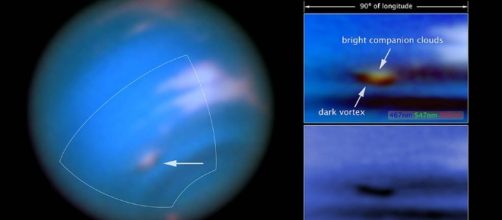Recent images taken by Hubble Space Telescope have revealed the presence of a dark turbulence, similar to the one seen on Jupiter, in Neptune´s atmosphere. The dark spot lies below a condensed bright cloud. It´s believed that the bright clouds may originate following the formation of the obscure vortex. Although these features were previously observed in the past century, this marks the first observation of them in the present century.
Anticycloneon Neptune
It´s believed that these features on the planet are high pressure systems that are usually accompanied with visible bright clouds.
Dark vortices are believed to be enormous lens-shaped gaseous mountains emanating from the interior with bright cloud formations on top of them. These features on Neptune´s atmosphere could be compared tomountains on earth and the companion clouds, are a lot like orographic clouds seen on top of Earth´s Mountains.
Orographic clouds
On earth these types of clouds usually originate by lifting air on the sides of a mountain. A mass of air may oscillate up and down as it moves through a landscape. When this mass encounters a mountain, the air is lifted upward along its uphill sides. When it reaches a certain altitude, it condenses and becomes visible as a cloud.
New evidence of dark spot
The observations of a black spot concealed by a cumulus of bright cloud on top was observed again by amateur observers and astronomers on the first days of July 2015 and in September of the same year the Outer Planet Atmospheres Legacy (OPAL) program detected a dark spot revealed the presence of a dark spot near the white clouds.
New Hubble images confirmed the observation and allowed scientists to create a high quality map of the feature.
Neptune and Jupiter
The dark vortices on Neptune have fluctuated, in size, shape, and location over the years. They change latitude at fast or slow speeds. They also appear and disappear in short time periods, in contrast with similar high pressure systems (anticyclones) observed in Jupiter´s atmosphere, which are known to evolve over larger periods of time.
It´s believed that the appearance of a dark vortex is followed by the development of bright clouds. The observation was made in the blue wavelength spectrum with Hubble telescope´s high resolution camera. Evaluating of the evolution of the newly discovered dark vortex and its surrounding atmosphere will broaden the understanding about the formation of this type of phenomena in the cosmos, thus expanding ourknowledge in astronomy.

